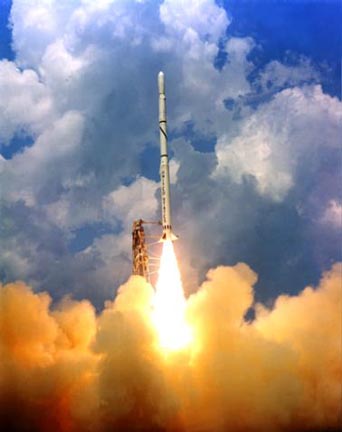|
Scout Launch Vehicle
Scout launch vehicle Credits - NASA

NASA’s Scout (Solid Controlled Orbital Utility Test) was America's first solid-fuel launch vehicle capable of orbiting a satellite. The standard Scout launch vehicle was a solid-propellant, four-stage booster system, approximately 75 feet (23 meters) long with a launch weight of 47,398 pounds (21,500 kilograms).
The first Scout vehicle was launched from NASA’s Wallops Flight Facility, Wallops Island, Virginia, on July 1, 1960. The rocket carried a 193-pound (88-kilogram) payload as a probe test. On February 16, 1961, Scout became the first solid-fuel rocket to place a payload into orbit. The vehicle carried a 96-pound (44-kilogram) NASA atmospheric physics payload into orbit without incident.
Two other launch sites were added in subsequent years. One, at the Western Range at Vandenberg Air Force Base, California, was added in 1962. Another was built on Italy’s sea-based San Marco platform off the east coast of Kenya, Africa.
Scout was a reliable rocket for nearly 34 years, and became one of NASA's most successful launch vehicles. Its reliability since 1968 was 98.3 percent and, since 1976, its launch success rate was 100 percent.
Unlike most of NASA's larger expendable rockets, the Scout was assembled and the payload integrated and checked-out in the horizontal position before being raised to the vertical orientation before launch. Scout’s first-stage motor was based on an earlier version of the navy's Polaris missile motor. The second-stage motor was developed from the army's Sergeant surface-to-surface missile, and the third- and fourth-stage motors were adapted by NASA’s Langley Research Center from the navy's Vanguard missile.
The Scout had its beginnings as early as 1957. The U.S. needed a relatively inexpensive, quickly produced rocket to launch small research experiments, and engineers at Langley Research Center were asked to design it. Their goal was to provide a launch vehicle capable of performing a variety of probe, reentry and orbital missions with minimum preparation time. The concept was complete in 1958, and Chance Vought Aircraft was placed under contract in March 1959 to build Scout vehicles.
Scout capability grew dramatically over the years. Originally able to place a 131-pound (59-kilogram) payload in a nominal 345-mile (552-kilometer) circular orbit, Scout performance was improved, increasing its capability to put a 458-pound (208-kilogram) payload into the same orbit. The heaviest satellite it ever placed in orbit was an Italian payload that weighed more than 600 pounds (270 kilograms). Scout increased its load-carrying capability 350 percent over that of the original vehicle with little increase in the size of its stages.
The last Scout launch took place in May 1994, when it launched a Miniature Sensor Technology Integration satellite. This was its 118th flight after almost 34 years of service.
|



